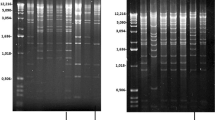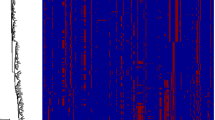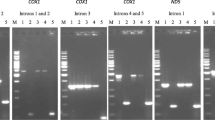Summary
In a previous publication it was shown that the output of yeast mitochondrial loci lacking nearby intergenic sequences (encompassing ori/rep elements) was reduced in crosses to strains with wild-type mtDNAs. In the present work, mitochondrial genomes carrying the intergenic deletions were marked at unlinked, loci by introducing specific antibiotic resistance mutations against erythromycin, oligomycin and paromomycin. These marked genomes were used to follow the output of unlinked regions of the genome from crosses between the intergenic deletion mutants and wild-type strains. Transmission of genetically unlinked markers in coding regions was substantially reduced when an intergenic deletion was present on the same genome. In general the transmission of the antibiotic markers was the same as or slightly higher than the corresponding intergenic marker. These results indicate that the presence of an intergenic deletion in the regions studied impairs the transmission to progeny of a mitochondrial genome as a whole. More specifically, the results suggest that ori/rep sequences, present in the regions that have been deleted, confer a competitive advantage over genomes lacking a full complement of such sequences. These results support the hypothesis that intergenic sequences, and specifically ori/rep elements, have a biological role in the mitochondrial genome. However, because of the exclusive presence of ori/rep sequences in the genus Saccharomyces, it may be that these sequences evolved in (or invaded) the mitochondrial genome relatively late in the evolution of the yeasts. Therefore, in a more general sense, variations in the amount and structure of intergenic sequences in various yeasts may reflect processes that have been of selective advantage in the metabolism of individual mitochondrial DNA in a particular environment and that have not drastically interrupted the respiratory phenotype.
Similar content being viewed by others
References
Aufderheide KJ, Johnson RG (1976) Cytoplasmic inheritance in Saccharomyces cerevisiae: comparison of zygotic mitochondrial inheritance patterns. Mol Gen Genet 144:289–299
Baldacci G, Cherif-Zahar B, Bernardi G (1984) The initiation of DNA replication in the mitochondrial genome of yeast. EMBO J 3:2115–2120
Bernardi G (1979) The petite mutation in yeast. Trends Biochem Sci 4:197–201
Bernardi G (1982) Evolutionary origin and the biological function of noncoding sequences in the mitochondrial genome of yeast. In: Slonimski PP, Borst P, Attardi G (eds) Mitochondrial genes. Cold Spring Harbor Laboratory Press, Cold Spring Harbor, New York, pp 269–278
Bernardi G, Bernardi G (1986) Compositional constrains and genome evolution. J Mol Evol 24:1–11
Birky CW Jr (1978) Transmission genetics of mitochondria and chloroplasts. Annu Rev Genet 12:471–512
Blanc H, Dujon B (1980) Replicator regions of the yeast mitochondrial DNA responsible for suppressiveness. Proc Natl Acad Sci USA 77:3942–3946
Cavalier-Smith T (1985) Introduction: the evolutionary significance of genome size. In: Cavalier-Smith T (ed) The evolution of genome size. Wiley, Chichester, pp 1–36
Chambers P, Gingold E (1986) A direct study of the relative synthesis of petite and grande mitochondrial DNA in zygotes from crosses involving suppressive petite mutants of Saccharomyces cerevisiae. Curr Genet 10:565–571
Clark-Walker GD (1985) Basis of diversity in mitochondrial DNAs. In: Cavalier-Smith (ed) The evolution of genome size. Wiley, Chichester, pp 277–297
Clark-Walker GD, Evans RJ, Hoeben P, Mcarthur CR (1985) The basis of diversity in yeast mitochondrial DNAs. In: Quagliariello E, Slater EC, Plamieri F, Saccone C, Kroon AM (eds) Achievements and perspectives of mitochondrial research, vol II. Biogenesis. Elsevier, Amsterdam, pp 71–78
DeZamaroczy M, Bernardi G (1985) Sequence organization of the mitochondrial genome of yeast — a review. Gene 37:1–17
DeZamaroczy M, Bernardi G (1987) The AT spaces and the var1 genes from the mitochondrial genomes of Saccharomyces cerevisiae and Torulopsis glabrata: evolutionary origin and mechanism of formation. Gene 54:1–22
Dixon M, Webb EC (1958) Enzymes. Longmans, London, pp 86–87
Dujon B (1981) Mitochondrial genetics and functions. In: Strathern, Jones EW, Broach JR (eds) The molecular biology of the yeast Saccharomyces. Life cycle and inheritance. Cold Spring Harbor Laboratory Press, Cold Spring Harbor, New York, pp 505–635
Dujon B, Slonimski PP (1976) Mechanisms and rules for transmission, recombination and segregation of mitochondrial genes in Saccharomyces cerevisiae. In: Bücher (ed) Genetics and biogenesis of chloroplasts, and mitochondria. Elsevier/North-Holland, Amsterdam, pp 393–403
Dujon B, Slonimski PP, Weil L (1974) Mitochondrial genetics. IX. A model for recombination and segregation of mitochondrial genomes in Saccharomyces cerevisiae. Genetics 78:415–437
Ehrlich SD, Thiery JP, Bernardi G (1972) The mitochondrial genome of wild-type yeast cells. III. The pyrimidine tracts of mitochondrial DNA. J Mol Biol 65:207–212
Ephrussi B, Hottinguer H, Chiminis Y (1949) Action de l'acriflavine sur les levures. I. La mutation “petite colonie”. Ann Inst Pasteur 76:351–368
Evans RJ, Clark-Walker GD (1985) Elevated levels of petite formation in strains of Saccharomyces cerevisiae restored to respiratory competence. II. Organisation of mitochondrial genomes in strains having high and moderate frequencies of petite mutant formation. Genetics 111:403–432
Evans RJ, Oakley KM, Clark-Walker GD (1985) Elevated levels of petite formation in strains of Saccharomyces cerevisiae restored to respiratory competence. I. Association of both high and moderate frequencies of petite mutant formation with presence of aberrant mitochondrial DNA. Genetics 111:389–402
Fangman WL, Dujon B (1984) Yeast mitochondrial genomes consisting of only A-T base pairs replicate and exhibit suppressiveness. Proc Natl Acad Sci USA 81:7156–7160
Gingold EB (1981) Genetic analysis of the products of a cross involving a suppressive ‘petite’ mutant of Saccharomyces cerevisiae. Curr Genet 3:213–220
Goursot R, DeZamaroczy M, Baldacci G, Bernardi G (1980) Suppressive petite mutants of yeast. Curr Genet 1:173–176
Hyman BC, Harris Cramer J, Rownd RH (1983) The mitochondrial genome of Saccharomyces cerevisiae contains numerous, densely spaced autonomously replicating sequences. Gene 26:223–230
Lukins HB, Tate JR, Saunders GW, Linnane AW (1973) The biogenesis of mitochondria. 26. Mitochondrial recombination: the segregation of parental and recombinant mitochondrial genotypes during vegetative divisions of yeast. Mol Gen Genet 120:17–25
Nasmyth KA, Reed SI (1980) Isolation of genes by complementation of yeast: molecular cloning of a cell-cycle gene. Proc Natl Acad Sci USA 71:4612–4616
Orgel LE, Crick FHC, Sapienza C (1980) Selfish DNA. Nature 288:645–646
Piškur J (1988a) A 5 kb intergenic region containing ori1 in the mitonchodrial DNA of Saccharomyces cerevisiae is dispensable for expression of the respiratory phenotype. FEBS Lett 229:145–149
Piškur J (1988b) Transmission of yeast mitochondrial loci to progeny is reduced when nearby intergenic regions containing ori/rep sequences are deleted. Mol Gen Genet 214:425–432
Piškur J (1988c) Sensitivity of intergenic regions of yeast mitochondrial DNA to single-strand-specific nucleases. FEBS Lett 238:435–440
Piškur J (1988d) Transmission of the yeast mitochondrial genome: the impact of intergenic sequences. Ph D Thesis, Australian National University, Canberra
Piškur J (1989) Respiratory-competent yeast mitochondrial DNAs generated by deleting intergenic regions. Gene (in press)
Rayko E, Goursot R, Cherif-Zahar B, Melis R, Bernardi G (1988) Regions flanking ori sequences affect replication efficiency of the mitochondrial genome of ori-plus petite mutant from yeast. Gene 63:213–226
Sena E, Welch J, Fogel S (1976) Nuclear and mitochondrial DNA replication during zygote formation and maturation in yeast. Science 194:433–435
Sriprakash KS, Molloy PL, Nagley P, Lukins HB, Linnane AW (1976) Biogenesis of mitochondria XLI. Physical mapping of mitochondrial genetic markers in yeast. J Mol Biol 104:485–503
Weisman LS, Wickner W (1988) Intervacuole exchange in the yeast zygote: a new pathway in organelle communication. Science 241:589–591
Wilkie D, Thomas DY (1973) Mitochondria genetic analysis by zygote cell lineages in Saccharomyces cerevisiae. Genetics 73:367–377
Wolf K, Dujon B, Slonimski PP (1973) Mitochondrial genetics V. Multifactorial mitochondrial crosses involving a mutation conferring paromomycin-resistance in Saccharomyces cerevisiae. Mol Gen Genet 125:53–90
Zinn AR, Pohlman JK, Perlman PS, Butow RA (1987) Kinetic and segregational analysis of mitochondrial DNA recombination in yeast. Plasmid 17:248–256
Author information
Authors and Affiliations
Additional information
Communicated by R. Hagemann
Rights and permissions
About this article
Cite this article
Piškur, J. Transmission of the yeast mitochondrial genome to progeny: The impact of intergenic sequences. Mol Gen Genet 218, 161–168 (1989). https://doi.org/10.1007/BF00330579
Received:
Issue Date:
DOI: https://doi.org/10.1007/BF00330579




